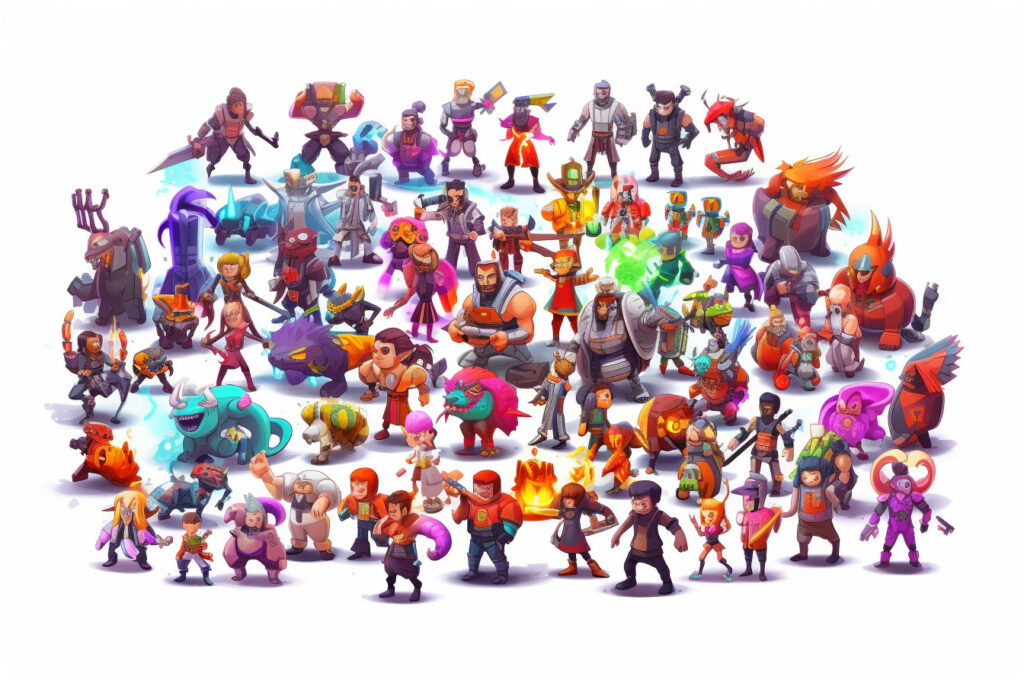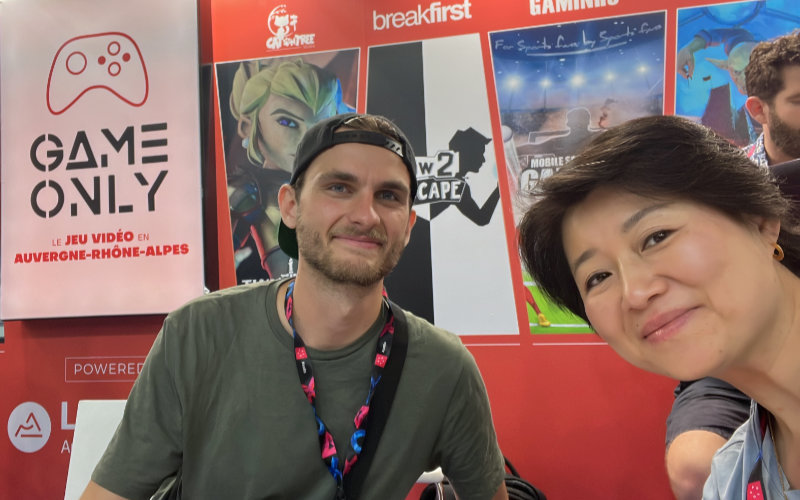
AI’s Influence in Video Games: Insights from Gamescom 2023
After getting back from Gamescom 2023, the team at NABIYA took a week to reflect on what we found to be some some of the most interesting takeaways. Notably, we had the privilege of listening to a panel of experts discuss the use of Artificial Intelligence (AI) in the world of video games.
Julien Millet from United Bits Games spoke on the use of generative AI and its ethical implications, and Serafim Pinto from Anybrain discussed AI in anti-cheating technology. From optimizing workflow to enhancing the user experience, AI is becoming an increasingly driving force behind the industry. Like with all new technology, the first step is to understand its potential, push its boundaries, and discover its limitations.


In What Ways Can We Harness Generative AI for Video Game Development?
AI-Powered Brainstorming: A Game Developer’s Best Friend
Millet begins his discussion of generative AI by outlining the number one application of generative AI in game development: brainstorming. Capable of generating dozens of ideas like locations, items, and characters in seconds, generative AI acts like an “assistant that never gets tired.” By tapping into vast databases of knowledge, it facilitates the creative process, helping developers cherry-pick the best concepts for their game.
Like many studios, we at NABIYA have been making extensive use of AI as a tool in much the same way. We have found that it works very well for brainstorming, refining ideas, and to serve as a starting point when creating concept art.
NPC Dialogue: Crafting Meaningful Interactions
Another commonly-discussed use of Generative AI is for Non-Player Character (NPC) dialogue. While it is great that players can now talk to NPCs about anything and everything, the key is using this tool to create meaningful interactions. At the end of the day, this means having a clearly defined intention for the NPC in question: what is their role in the story, and what should the player get out of their interaction with them? Adding depth to the character or adjusting things like age or accent is possible, but all of this still requires input, direction, and thought from the game developers. Generative AI may introduce this new layer to NPC development, but learning how to effectively utilize it in order to improve the user experience will be the crux for game designers.
NPC Intelligence: The AI Revolution
Millet also discussed AI’s use for simulating NPC intelligence. He used strategy games like F.E.A.R. and StarCraft as examples of how it has been done in the past. For years, game AI have relied on a sort of illusion to simulate intelligence – while it had access to complete knowledge of the player’s activity, the trick was to give the impression that it didn’t. Despite not needing to scout, explore the map, and so on, it would do so in an attempt to mimic a player’s behavior. Now that AI is approaching ‘true’ intelligence, game developers will be able to play with these new tools in strategy games and other genres in order to create fresh experiences.
The possible implementation of modern AI in NPCs is still limited. Currently they would have to query OpenAi for too long. Millet also touches upon NPC animation in Ubisoft, in which AI is used to determine which animation would be the best to use in a given situation. These new tools are not yet truly transformative, but are instead “like small bricks that can be used here and there, seamlessly.”
We are working closely with the tech company PI Lighting to create an advanced AI tool in an upcoming project that will be part of our original IP, ELEMENTS. We hope that this tool would not only allow players to engage with NPCs conversationally, but also for these NPCs to truly change their behavior and attitudes in response to the player’s dialogue and gameplay choices. The idea is that this would allow for each playthrough to be truly unique.We are working with the tech company PI Lighting to explore the possibility of creating an advanced AI tool for an upcoming project that will be part of our original IP, ELEMENTS. We hope that this tool, “Persona Grata AI,” will not only allow players to engage with NPCs conversationally, but also for these NPCs to truly change their behavior in response to the player’s dialogue and gameplay choices. The idea is that this would allow for each playthrough to be truly unique.
AI in Image Generation: Unleashing Creativity
Generative AI also finds its place in the realm of image generation and concept art. This application raises justified concerns about job security, but it cannot be denied that it is also a valuable tool that can be used to streamline the production chain, allowing artists to focus on higher-level aspects of their craft, ultimately benefiting the game development process.
What are The Ethical Implications of Using AI in Art?
Wizards Of The Coast, the company behind Dungeons & Dragons, recently addressed the fact that one of their artists had employed AI to aid in the creation of artwork. Using this recent news as a jumping off point, Camille Guillemot from Bodyguard.ai asked her panel what they think about the burden of communication and proof regarding the use of AI in creative processes.
Millet highlighted the fact that when AI is involved in the creative process, the lines between human and machine can become blurred. For example, if AI generates an initial concept (based on a human-made prompt), and is subsequently edited and refined by human concept artists, to what extent should the work be attributed to AI? The process of using AI in the creation of art isn’t as simple as writing a few sentences and suddenly having an amazing finished product; a human mind is always involved, though admittedly to varying degrees.
Millet draws a parallel between the use of AI and the practice of sampling in Hip-Hop music. In both cases, previously-existing content serves as a foundation, and technology as a tool, but the true artistry lies in the subsequent tweaks made by human artists. Just as musicians may sample existing songs to create infinitely new and unique pieces, artists are now leveraging AI as a tool to spark their creativity and streamline their workflow.
The ethical questions do not end there. Where do we draw the line for the rights and compensation of the artists involved? Who holds ownership over AI-generated creations, how should artists be remunerated for their collaborative work with AI, and what happens when artists make claims that AI (and the companies developing them) have unjustly used their art or data? Consider also what happens if copyright laws change, and artists seek compensation for their unique style or creative elements “borrowed” by AI. In light of these questions, organizations like the European Guild For Artificial Intelligence Regulation (EGAIR) have emerged to draw attention to, and advocate for, artists’ rights in the age of AI. Similarly, Valve has announced that it will not approve Steam games that use copyright-infringing artwork created with AI assistance.
Millet emphasizes the importance of concept artists standing up for their rights and understanding the evolving landscape of AI-assisted creation. As advanced AI tools become more accessible, artists should adapt and learn how to effectively collaborate with these systems. Like myself and many others, Millet shares the optimistic view of the future in which AI does not replace artists, but rather augments and enhances their creative capabilities.
As AI becomes increasingly sophisticated, we will continue to see growing concerns about its impact on the creative workforce. Notably, the Writers Guild of America (WGA) and Screen Actors Guild-American Federation of Television and Radio Artists (SAG-AFTRA) are engaged in an ongoing fight against massive corporations who are threatening to lay off or underpay artists en masse, thanks to the increasingly likely possibility of using AI in their place. Could we eventually witness a similar scenario in the gaming industry?
How Does AI Ensure Fair Play in Video Games?
In the world of multiplayer video games, the stakes have never been higher. E-Sports is a rapidly emerging industry, in-game economies often increasingly substantial value, and gamers can connect and play from anywhere at any given time. The problem of cheating has evolved since the days when it was considered a harmless pastime. Serafim Pinto shed light on the ways Anybrain uses AI to combat cheating in gaming.
Unlike the past, where cheat detection was reactive, modern processing power allows AI to detect and take action against cheating in real-time, leveling the playing field for all gamers. These predictive AI systems learn and adapt in real-time. This AI it focuses on the behavioral patterns of cheating players, monitoring their mouse, keyboard, and in-game actions for extreme and sudden changes. This method is software-agnostic, making it highly effective regardless of the cheating tools employed. Pinto likens this type of anti-cheating technology to an antivirus.
To illustrate the effectiveness of their approach, Anybrain shared a concrete example. After implementing their anti-cheating AI, their clients noticed a significant drop in daily active users (DAU), due to permanent bans for detected cheaters. While this might seem like a blessing, it also meant banning of players that may have only cheated once. Such massive drops of DAU, especially when a game is still growing, can be devastating.
As a result, instead of immediately banning cheaters, they began to issue warnings to detected cheaters, informing them that the next instance of cheating would result in a permanent ban. Over the course of 4-6 months, a remarkable 80% of players detected as cheaters stopped using cheats in this game. This approach not only improved the gaming experience by removing cheaters but also preserved the player base for a longer period.
While anti-cheating AI may be incredibly effective today, they claim that the last step is explainability: presenting proof to the players. Their hope is that AI in the future will have the capacity to explain and provide concrete evidence of cheating or fraud. This would not only minimize the already small risk of falsely identifying cheaters, it would also serve as reassurance to prospective players and clients. Achieving such explainability in AI, they claim, is the final frontier in the battle against cheating.
The gaming industry’s willingness to adopt and harness AI for anti-cheating measures is a testament to its forward-thinking nature. Instead of rejecting the idea of AI’s involvement in gameplay, many video game studios are embracing these technologies to maintain fair play and enjoyable experiences for their player communities.
The Future of Gaming and AI: Embracing Innovation
The speakers on this panel agreed that we are not only responsible for questioning and raising concerns about the use of AI, but also for training ourselves in how to use it as a tool. Julien Millet says that AI specialists have long agreed that AI will achieve a human-level capacity sometime between 2035-2040. As the technology evolves, we will continue to unlock new ways to leverage it in the gaming industry and beyond. The key is to embrace experimentation, understand its capabilities, and navigate the fine balance between innovation and creativity.